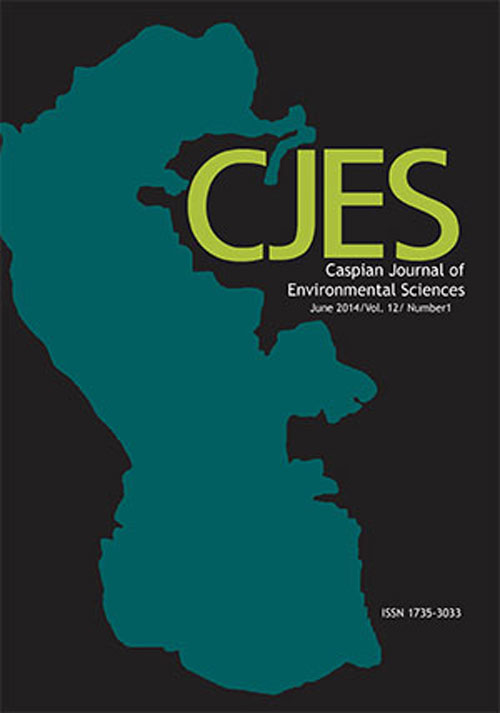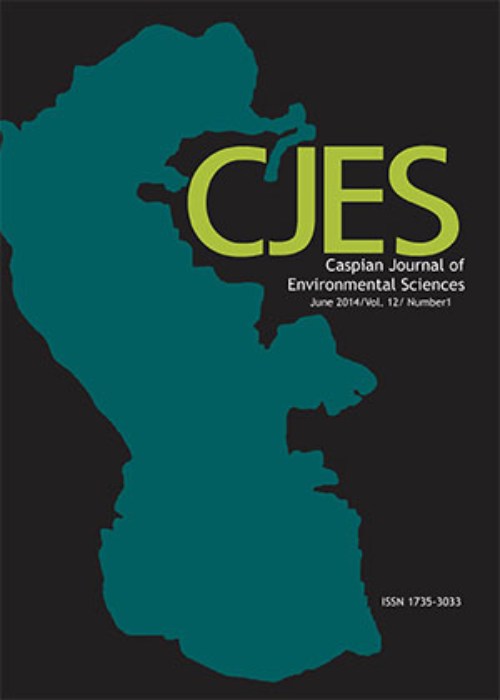فهرست مطالب

Caspian Journal of Environmental Sciences
Volume:18 Issue: 4, Autumn 2020
- تاریخ انتشار: 1399/06/30
- تعداد عناوین: 8
-
-
صفحات 383-395
-
Pages 295-307
The aim of this work is to assess the in vitro antibacterial activity of the extracted essential oil (EO) obtained from dry seeds of fennel, Foeniculum vulgare Mill, collected from Meknes, (Morocco), against seven pathogenic bacteria: Escherichia coli, Klebsiella pneumoniae, Enterobacter cloacae, Pseudomonas aeruginosa, Acinetobacter baumannii, Staphylococcus epidermidis and Staphylococcus aureus. The extraction of EO from fennel was performed by hydro-distillation in the Clevenger-type device. The yield was close to 2.82%. The identification of the chemical composition of fennel EO by gas chromatography coupled with mass spectrometry (GC/MS), has given 25 constituents. They represent 97.525% of all constituents existing in the essential oil. The major compound was the trans-anethole (with 44.376%). The result of this study showed that the fennel EO has a remarkable inhibitory activity against the majority of the examined microorganisms, especially against A. baumannii, with the exception of P. aeruginosa and E. coli, as compared to three standard antibiotics. It also exhibited a strong antimicrobial activity against A. baumannii (with a growth inhibition zone of 26 mm) compared to the standard antibiotics examined, with minimum inhibitory concentration (MIC) of 1/2000 (v/v) and S. aureus (growth inhibition zone of 20 mm) with MIC of 1/10000 (v/v). These results indicate that the fennel OE examined represents a potential source of natural antibacterial substances which can be used against pathogenic strains.
Keywords: Foeniculum vulgare Mill, Essential oil, Chemical composition, Inhibitory activity, MIC -
Pages 309-317
The main aim of this study is to consider the potential of different aquatic and terrestrial plants (Cyperus alternifolius, Amaranthus retroflexus, Closia cristata and Bambusa vulgaris( for phytoremediation of pollutants and phytodesalination through floating bed system. In this study, when Cyperus alternifolius plants were exposed to atrazine) 20 mg L -1(, OPC-LD )20 mg L -1(, OPC-LD )50 mg L -1(, fluorine )3.5 mg L -1(, and 1-4 Dioxane )25 mg L -1(, in a mesocosm treatment floating bed system, the phytoremediation efficiencies were 91.28 ± 6.35%, 82.33 ± 2.51 %, 75.67 ± 3.05%, 62.28 ± 5.77% and 42.29 ± 2.27 % respectively. When Amaranthus retroflexus plants were exposed to metformin )20 and 50 mg L-1( and OCP-LD )20 and 50 mg L-1(, 63 ± 5.24 %, 58.4 ± 2.11%, 38 ± 1.73 %, and 29 ± 01 % of the pollutants were removed. In the case of Closia cristata, the most efficiency belonged to metformin with a concentration of 50 mg L-1 . The results showed that in water containing NaCl in a range of 1000 to 2000 mg L-1 , Bambusa vulgaris with an efficiency of about 32.62 ± 4.65 % is a good candidate for phytodesalination. Consequently, C. alternifolius, a fast-growing plant with a good ecological stability in polluted water, can absorb pollutants and remains healthy after the treatment period. It is a good candidate for phytoremediation in vegetated floating beds.
Keywords: Phytoremediation, Emerging Contaminant, Water pollution, Cyperus alternifolius -
Pages 319-327
Water resources are relatively limited in Morocco, as well as in other South-Mediterranean countries, mainly because of the aridity of their climate, marked by recurrent droughts. On the other hand, the water needs are continuously growing and the main solutions adopted during the last 60 years to cover these needs were damming and groundwater pumping, and it is recently that the public departments resorted to the use of treated wastewaters. This water scarcity was progressively amplified by pollutions that reduce the availability of good quality waters. Indeed, the population increase led to an exponential and concomitant expansion of urban, industrial and agricultural activities, which pollute both surface and underground waters, making their use as a big challenge for public sectors. Therefore, both surface and underground waters need, today more than ever, to be sustainably managed. In this context, new diagnostics and syntheses are necessary, but the best way to tackle this challenge should be long-term surveys of the water quality. That means a crucial need to performant information system on this topic, covering the whole country and designed in the context of a decision-making mechanism, both strategic and operational. This work aims to verify the feasibility of such information system, using the example of the groundwater physicochemical parameters. A database has been designed and filled with a high proportion of available physicochemical data, proving that this database is technically feasible. The first synthesis attempts of these data with classical models revealed that they are relatively well adapted to the database structure. However, different obstacles prevent getting significant results. They are mainly due to imprecision and heterogeneity of the data format and the methods used. These obstacles were partly lifted by transforming and completing information, but many existing data will remain unexploited or with weak significance, particularly in spatiotemporal analyses. In addition, this study aims to suggest some standard methods for developing a monitoring that could be qualified as national.
Keywords: Groundwater, Morocco, Physicochemical parameters, Water quality database -
Pages 329-344
This present work revealed the isotherm, kinetic, and thermodynamic behaviour of methylene blue (MB) dye adsorbed onto acidic activated carbon (AAC) and base activated carbon (BAC) prepared from Raphia taedigera seed by carbonization and chemical activation. AAC and BAC were activated with sulphuric acid and sodium hydroxide respectively. Batch equilibrium studies were done under different experimental conditions such as MB dye concentration and temperature. The equilibrium data were modelled using Langmuir, Freundlich, Elovich, Temkin and Dubinin-Radushkevich isotherms. The Langmuir isotherm model best describes the uptake of MB dye onto AAC and BAC with R2 > 0.998 in all cases. The pseudo-first-order, pseudo-second-order and intra-particle diffusion equations were used to evaluate the kinetic properties. It was observed that the adsorption of MB dye onto the two activated carbons could best be described by the pseudo-second order equation with 0.999 < R2 ≤ 1. Thermodynamic parameters such as Gibbs free energy (ΔG0), standard enthalpy (ΔH0), standard entropy (ΔS0), and activation energy (Ea) were determined. The results of ΔG0indicated a spontaneous and feasible for AAC and non-spontaneous but feasible for BAC. Results of ΔH0 confirmed that the adsorption of MB onto AAC and BAC are endothermic and physical in nature. It can be concluded that AAC and BAC prepared from Raphia taedigera seed could be used as low-cost adsorbent for the removal of MB dye from the wastewater.
Keywords: Raphia taedigera, activated carbon, Langmuir, Kinetic, Methylene Blue -
Pages 345-356
Linear alkyl benzene Sulfonate (LAS) is a major anionic surfactant utilized in detergents around the world and is subsequently a ubiquitous water contaminant. This paper deals with assessing human health risk due to LAS in Anzali Wetland between different age groups. Water samples were collected from 50 stations in the wetland. LAS concentration was determined by spectrophotometry at 650 nm. The risk quotients (RQ) index was used to assess the human health risk assessment of LAS in the wetland. Based on the results, the health risk index was lower than 0.2 in all stations, indicating that there is no LAS contaminant risk for human health in this wetland. However, due to the presence of the different unregulated discharge of wastewater to the wetland, without strong policies to control and management, the risk of contamination may increase in the future.
Keywords: Anzali Wetland, Detergents, Linear alkyl benzene sulfonate (LAS), Health risk assessment, Risk quotients (RQs) -
Pages 357-366
Species distribution models (SDMs) are a tool for the management of wildlife including the roe deer, Capreolus capreolus, as an elusive and national protected herbivore in Iran. Habitat suitability modeling can be one of the most important steps to protect this species. This study was carried out to evaluate the potential distribution of the roe deer in the north and northwest of Iran and to identify the important habitat patches for this species. The habitat suitability modeling was applied 95 presence points and nine environmental variables by MaxEnt®. Thereafter, we focused on the extraction of important habitat patches based on presence points. The land cover, as the most important variable on the habitat suitability model of roe deer and its highest probability presence, is classified as the high and moderate densities in the forest. Habitat patches covered an area of about 4467.81 km2 (i.e., 6.04%of the study area). The largest habitat patch, covering an area about 4022 km2, created a continuous patch in the east of the study area. There were several inter-connected small patches in the most western part of the study area in Arasbaran forests. Actually, Habitat patches should be taken into consideration in the conservation of the roe deer.
Keywords: Animal conservation, Dense forests, Habitat modeling, MaxEnt -
Pages 367-381
Nowadays, considering the crises in the fisheries industry and especially shrimp fishery, the need to make decisions taking into account the stakeholder (STKH) groups is of great importance. Given designing a goal model with a multi-criteria decision-making approach, in addition to considering the varied and conflicting goals of the shrimp fishery groups in the Dayyer Port, the present study provides the best possible balance by providing some measures in the number of fishing days and number of fishing vessels in the two short- and long-term scenarios. The first finding indicates that maintaining the current activity level of fishery industry is a top priority for all STKH groups. Moreover, in the short-term scenario, despite the decrease in the volume of profit gained from hiring and employing process approximately by 4%, employee safety will increase by approximately 1% and bycatch will decrease by 14%. In the second scenario, although the gained profit from the catch will reduce safety, employment and maintenance of the fisheries current activity levels by 6%, 9%, 7% and 16%, respectively, the bycatch will be significantly reduced by 32%, thereby creating a good balance among the STKH groups.
Keywords: Fisheries, shrimp, Optimized shrimp fishery, Fuzzy hierarchical analysis, goal programing -
Pages 383-395
To date, only labour force and physical capital have been considered as factors of production in neoclassical growth patterns. But recently, the creation of differences in the level of production and income among countries, beyond the difference in physical capital, has led to more dimensions of the variable of capital being investigated. These explorations led to the arrival of variables of human and social capitals into a growth model. This study aimed to analyse the role of various types of capital in the Iranian economy. Hence, the neoclassical growth model and the data of period between 1974 and 2012 were used. Types of capital were added to physical capital, including human, social, and environmental capitals. The environmental capital was considered as carbon dioxide emission costs. The variables representing social capital included access to the internet as well as access to the telephone. In the case of human capital, three variables were used including literacy rate, enrolment rate in elementary school, as well as the students number. It was also assumed that technology, in addition to the workforce, would appear in the form of physical capital. The findings exhibited that physical capital was the most important factor in the growth of Iranian economy. However, a very small role was played by the variables of human and environmental capitals. The role of social capital has been estimated to be relatively acceptable and positive, which is about one- third to one-quarter of physical one.
Keywords: Economic Growth, Social Capital, Environmental Capital. JEL classification: O14, O45, R2


